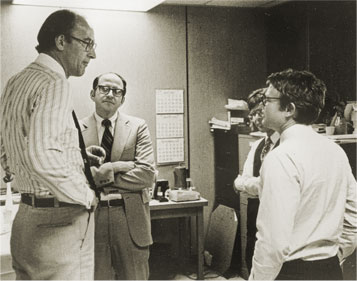

The campaign against insider trading faced a series of hurdles. The legal theories were still unsettled; while corporate insiders were clearly not allowed to use inside information to trade on their own companies’ stock, it was less clear when the ban applied to non-insiders. In cases in the early 1980s, the Supreme Court rejected theories that would have applied insider trading prohibitions to almost anyone in possession of nonpublic information. In 1980, in Chiarella, the Court overturned a criminal conviction for insider trading because prosecutors did not show a “relationship of trust and confidence” between the trader and stockholders from whom he bought shares.(1) In Dirks, a 1983 case, it held that someone trading on nonpublic information received from an insider – a “tippee” – would have violated the law only if it was shown that the provider of the information – the “tipper” received a personal benefit.(2) The Commission’s 1980 adoption of Rule 14e-3, which barred insider trading related to a tender offer, helped, but not until the 1990s would the Supreme Court clarify the law by embracing the “misappropriation theory” of insider trading.(3)

Weak remedies – a bane of the Commission – also made it difficult to prevent insider trading. Into the 1980s, the civil penalty for insider trading was at most an injunction and disgorgement of ill-gotten gains, the equivalent of requiring a defendant to “put the cookies back in the cookie jar.”(4) At one point, Fedders conceded the biggest deterrent to insider trading was “the personal embarrassment one suffers by the adverse publicity.”(5) Only in 1984 did growing public awareness lead Congress to adopt the Insider Trader Sanctions Act, which among other things empowered district courts to impose a sanction of up to three times wrongful profits gained, or losses avoided, for illegal tipping or trading.(6)
Despite this, the staff still battled insider trading with its characteristic tenacity. When insider trading moved abroad, the SEC extended its reach. In 1981 staffers identified likely insider trading ahead of takeover announcements for St. Joe Minerals and Santa Fe International. In both cases, however, the trading had occurred through Swiss bank accounts, and the banks refused to disclose the identity of those accounts’ owners, citing Swiss bank secrecy law.(7) The staff quickly struck back by persuading a Federal judge to levy “massive fines” against one of the banks and threatened to bar it from U.S. markets.(8) Within days the bank folded and identified the account holders, and inside a year Swiss and U.S. authorities had signed a Memorandum of Understanding (MOU) providing the SEC new access to information about foreign account holders, an agreement that would be replicated with other nations over the next decade.(9)
Such cases were never the whole, or even the majority, of the Division’s work during the 1980s. Accounting fraud, broker-dealer misconduct, and penny stock fraud all remained areas that consumed much of its time and resources.(10) That said, it was insider trading that caught the public’s eye and Enforcement attorneys’ interest. As Fedders recalled, all the junior attorneys “wanted to have one insider trading case among the cases they were investigating.”(11)
(1) Chiarella v United States, 445 US 222 (1980).
(2) Dirks v SEC, 463 US 646 (1983).
(3) Pitt & Shapiro, Regulation by Enforcement: 206.
(4) Id. at 210 n. 260.
(5) Kenneth B. Noble, Insider Cases and the SEC, NYT Jan 25, 1983: 60.
(6) Pitt & Shapiro, Regulation by Enforcement: 223.
(7) Vise & Coll, Eagle on the Street: 53-55.
(8) Banks Can’t Invoke Secrecy Laws, Federal Judge Rules, Wall St. J. Nov. 17, 1981: 24.
(9) SEC Annual Report 1983: 2.
(10) John Fedders oral history: 12; SEC Annual Report 1988: 2, 4.
(11) Fedders oral history: 12.
Donald C. Langevoort is the Thomas Aquinas Reynolds Professor of Law at Georgetown University Law Center. He joined the Georgetown faculty in 1999 after eighteen years at Vanderbilt University School of Law. Professor Langevoort graduated from the Harvard Law School in 1976, and went into private practice with the law firm of Wilmer, Cutler & Pickering in Washington. In 1978, he joined the staff of the U.S. Securities & Exchange Commission as Special Counsel in the Office of the General Counsel. Since entering academia in 1981, Professor Langevoort has written a treatise on insider trading, co-authored a casebook on securities regulation, and produced numerous law review articles on topics such as insider trading, the impact of technology on securities regulation, investor behavior and the intersection between cognitive psychology and lawyers’ professional responsibilities.